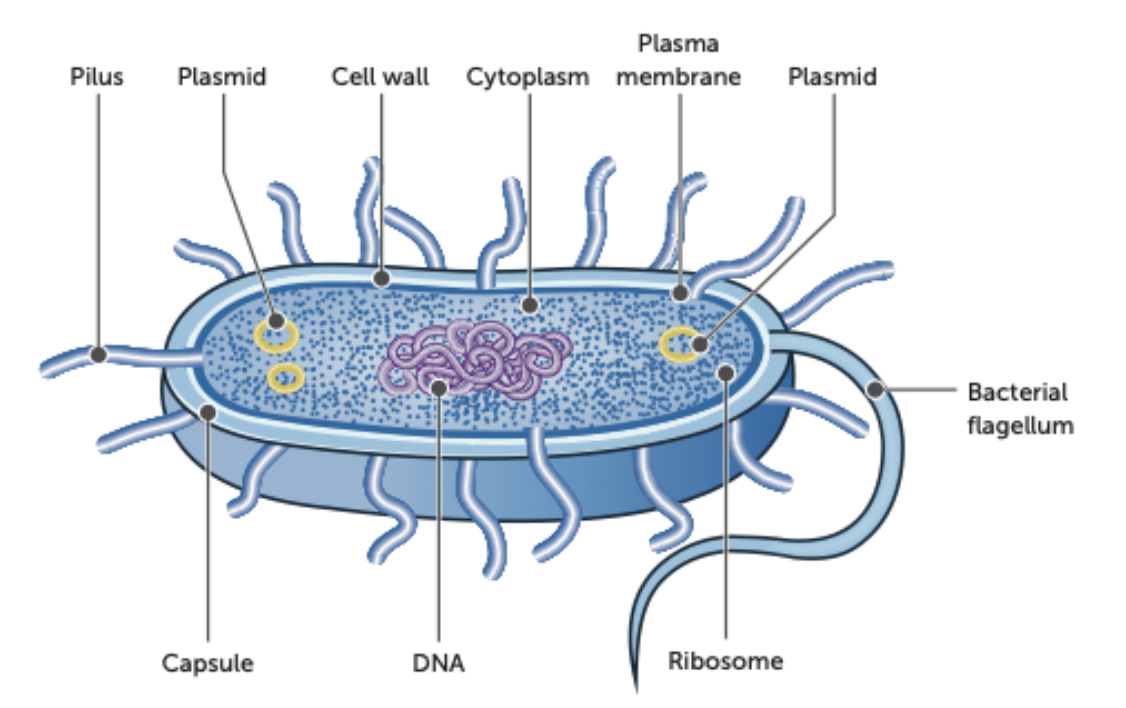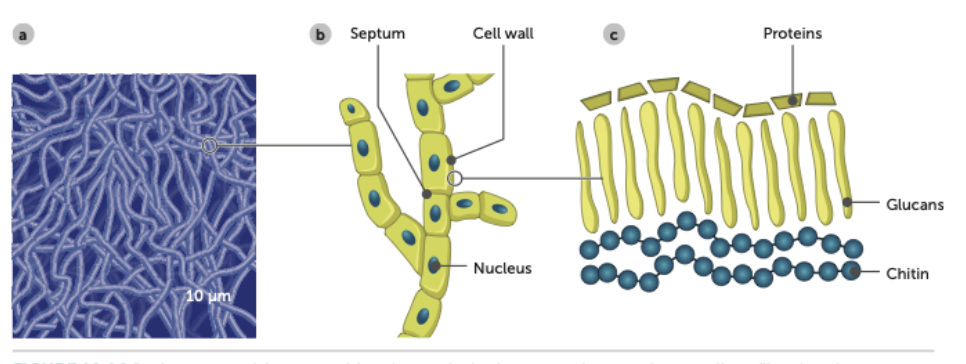Microorganisms that cause Disease
Bacteria
- Majority of bacteria are non-pathogenic (harmless to humans)
- Some are pathogenic (cause disease)
- Essential to life on Earth
- Decomposition of organic material and cycling of elements
- In/on the human body, bacteria colonise the gut, mouth, skin, genitals and airways
- Single-celled microscopic (0.1 - 5.0 μm) organisms
- Visible under light microscope
Prokaryotic
- No membrane-bound organelles
- No nucleus
- DNA
- Single circular molecule: bacterial chromosome
- Bacterial cell envelope
- Capsule
- Cell wall
- Generally comprised of peptidoglycan
- Sugars and amino acids
- Generally comprised of peptidoglycan
- Cell membrane
- Similar to that of other cells
- Similar to that of other cells
Types of Bacteria
- Bacteria are classified into groups based on their basic shapes
- Spherical shape: coccus
- Rod shaped: bacillus
- Curved:
- Spiral: spirilla
- Comma: vibrio
Cocci - NOTE: NOT NEEDED
- Spherical cells
- Can occur
- Singly
- In pairs (diplococci)
- In clusters (staphylococci)
- In chains (streptococci)
Bacilli - NOTE: NOT NEEDED
- Rod-shaped cells
- Have flagella for movement
- Can occur
- Singly (bacillus)
- In chains (streptobacillus)
- Oval (coccobacillus)
Curved - NOTE: NOT NEEDED
- Spirilla
- Thick, rigid spiral
- Vibrio
- Curved or comma shaped rod
- Spirochaetes
- Thin, flexible spiral
- Corkscrew
Cholera
- Vibrio cholera
- Lives in water and human hosts
- Halophilic: salt loving
- Highly motile(not a typo, i thought it was though ;-; ): moves very well using flagella (tail-like structure)
- Causes acute diarrhoeal infection when ingested through contaminated food or water
Bacteria DNA Fishing
- Bacteria use pili to harness DNA from dead bacteria to incorporate into their own DNA
- Horizontal gene transfer
- Evolutionary advantage such as obtaining antibiotic resistance

Viruses
- Individual virus is called a virion
- Sub-microscopic particle (20-300 nm)
- Visible under electron microscope
- Non-cellular
- Doesn’t have cell membranes, cytoplasm, ribosomes and other cell organelles
- Unable to make proteins or even replicate on their own
- Instead they must depend on a host cell to synthesis their proteins and replicate
- Can contain either DNA or RNA
- A virion consists of
- Nucleic acid core (RNA or DNA) surrounded by a protective protein coat (Capsid)
- Sometimes they have a lipid envelope covering the protein capsid (enveloped virus)
Types of virus
- RNA virus
- Usually single stranded
- Can be double stranded
- DNA virus
- Usually double stranded
- Can be single stranded
Virus Replication
- As viruses are non-cellular, they don’t reproduce on their own like living organisms, instead they infect a host cell to replicate (make multiple copies of themselves)
- They infect a wide variety of organisms, including eukaryotes and prokaryotes
- Once inside the host cell, they use the cell’s ATP(Adenosine Triphosphate), ribosomes, enzymes and other cellular parts to replicate
Fungi
-
Most are multicellular
- Yeast: uni-cellular fungi
-
Heterotrophs
-
Cell walls made of chitin (fibrous substance consisting of polysaccharides)
-
Cell membrane has phospholipid bilayer
-
Eukaryotic
- Membrane-bound organelles with DNA
- Membrane-bound organelles
-
Microscopic to macroscopic
-
Reproduce by forming spores
-
Fungal disease: pneumocystis pneumonia caused by Pneumocystis jirovecii

Protist
- Large diverse group of microorganisms that aren’t plants, animals or fungi
- Between 60000-200000 different species
- Microscopic to macroscopic
- 10 µm (unicellular protists) to several meters or more (multicellular seaweeds)
- Unicellular, multicellular or colonial
- Eukaryotic with nuclear membranes and membrane-bound organelles
- Most protists are aquatic organisms
- Nucleus with DNA
- Animal-like protists: Protozoa
- Single-celled eukaryotes unlike animals that are multi-cellular
- Like animals, they can move, and are heterotrophs
- Size: 0.01-0.5 mm
- Animal-like protists include the flagellates, ciliates, amoeba and apicomplexa
| Type of Protazoa | Movement | Example |
|---|---|---|
| Flagellates | Long flagela/tails that rotate in a propeller-like fashion | Trypanosoma: African sleeping sickness |
| Pseudopodia (temporary feet.) Amoebae | Extends projections of cytoplasm out to form feet-like structures that propel the cell forward | Naegleria fowleri, deadly brain infections |
| Ciliates | Cillia = tiny tail-like projections that extend outward from the cell body and beat back and forth | Paramecium |
| Apicomplexa | They don’t move, are intracellular parasites. They use special enzymes to penetrate the host’s tissues. Complex life cycle involving transmission between several host species | Plasmodium: spread by mosquitoes as malaria |
- Plant-like protists
- Algae are plant-like protists
- Large and diverse group
- Autotrophs
- Don’t have true stems, roots or leaves unlike plants
- Most plant-like protists live in oceans, ponds and lakes
- Can be uni-cellular or multi-cellular
- Plants are multi-cellular
- Example: Kelp and seaweed
- Fungi-like protists
- Share many characteristics with fungi
- Heterotrophs
- Reproduce by forming spores
- Differ from fungi as their cell walls are made of cellulose, fungi’s cell walls are made of chitin
- 2 major types of fungus-like protists
- Slime moulds
- Grow as slimy masses on decaying matter
- Commonly found on items such as rotting logs
- Water moulds
- Live in moist soil and surface water
- Exist as parasites or feed on decaying organisms
- Slime moulds
